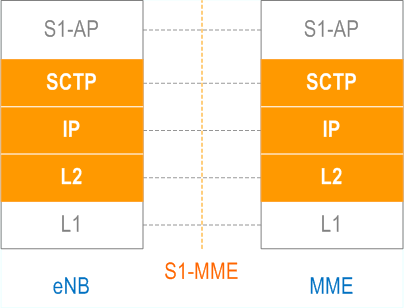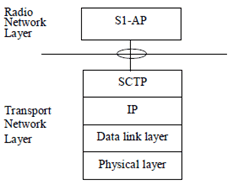TS 36.412
E-UTRAN – S1 Interface
Signalling Transport
V18.1.0 (PDF)
2024/06 10 p.
V17.0.0
2022/03 10 p.
V16.0.0
2020/03 10 p.
V15.0.0
2018/06 10 p.
V14.0.0
2017/03 10 p.
V13.0.0
2015/12 10 p.
V12.0.0
2014/09 10 p.
V11.0.0
2012/09 10 p.
V10.1.0
2011/06 10 p.
V9.1.1
2011/04 10 p.
V8.6.0
2009/12 10 p.
- Rapporteur:
- Mr. Min, Tianyang
NTT DOCOMO INC.

Content for TS 36.412 Word version: 18.1.0
1 Scope
2 References
3 Definitions and abbreviations
4 S1 signalling bearer
5 Data link layer
6 IP layer
7 Transport layer
$ Change History
1 Scope p. 5
The present document specifies the standards for signalling transport to be used across S1 interface. S1 interface is a logical interface between the eNB and the E-UTRAN core network. The present document describes how the S1-AP signalling messages are transported over S1.
2 References p. 5
The following documents contain provisions which, through reference in this text, constitute provisions of the present document.
- References are either specific (identified by date of publication, edition number, version number, etc.) or non-specific.
- For a specific reference, subsequent revisions do not apply.
- For a non-specific reference, the latest version applies. In the case of a reference to a 3GPP document (including a GSM document), a non-specific reference implicitly refers to the latest version of that document in the same Release as the present document.
[1]
TR 21.905: "Vocabulary for 3GPP Specifications".
[2]
RFC 2460 (1998-12): "Internet Protocol, Version 6 (IPv6) Specification".
[3]
RFC 791 (1981-09): "Internet Protocol".
[4]
RFC 2474 (1998-12): "Definition of the Differentiated Services Field (DS Field) in the IPv4 and IPv6 Headers".
[5]
RFC 4960 (2007-09): "Stream Control Transmission Protocol".
[6]
IANA: "Stream Control Transmission Protocol (SCTP) Parameters", [https://www.iana.org/assignments/sctp-parameters/sctp-parameters.xhtml#sctp-parameters-25 ].
[7]
IANA: "Service Name and Transport Protocol Port Number Registry", [https://www.iana.org/assignments/service-names-port-numbers/service-names-port-numbers.xhtml ].
3 Definitions and abbreviations p. 5
3.1 Definitions p. 5
For the purposes of the present document, the terms and definitions given in TR 21.905 and the following apply. A term defined in the present document takes precedence over the definition of the same term, if any, in TR 21.905.
S1:
interface between an eNB and an EPC, providing an interconnection point between the EUTRAN and the EPC. It is also considered as a reference point.
S1-MME:
Reference point for the control plane protocol between E-UTRAN and MME.
3.2 Abbreviations p. 5
For the purposes of the present document, the following abbreviations apply.
eNB
E-UTRAN Node B
EPC
Evolved Packet Core
DiffServ
Differentiated Service
IP
Internet Protocol
MME
Mobility Management Entity
PPP
Point to Point Protocol
SCTP
Stream Control Transmission Protocol
4 S1 signalling bearer p. 6
4.1 Functions and protocol stack p. 6
S1 signalling bearer provides the following functions:
- Provision of reliable transfer of S1-AP message over S1-MME interface.
- Provision of networking and routeing function
- Provision of redundancy in the signalling network
- Support for flow control and congestion control

The transport network layer is based on IP transport, comprising SCTP on top of IP.
5 Data link layer p. 6
The support of any suitable data link layer protocol, e.g. PPP, Ethernet, etc. , shall not be prevented.
6 IP layer p. 6
The eNB and MME shall support IPv6 (RFC 2460) and/or IPv4 (RFC 791).
The IP layer of S1-MME only supports point-to-point transmission for delivering S1-AP message.
The eNB and MME shall support the Diffserv Code Point marking as described in RFC 2474
7 Transport layer p. 7
SCTP (RFC 4960) shall be supported as the transport layer of S1-MME signalling bearer. The Payload Protocol Identifier (ppid) to be used by SCTP for the application layer protocol S1AP is assigned by IANA in [6]. The byte order of the ppid shall be big-endian.
SCTP refers to the Stream Control Transmission Protocol developed by the Sigtran working group of the IETF for the purpose of transporting various signalling protocols over IP network.
There shall be only one SCTP association established between one MME and eNB pair.
The eNB shall establish the SCTP association. The SCTP Destination Port number value assigned by IANA to be used for S1AP is 36412.
The eNB shall establish the SCTP association. The SCTP Destination Port number value to be used by S1AP is assigned by IANA in [7].
Within the SCTP association established between one MME and eNB pair:
- a single pair of stream identifiers shall be reserved for the sole use of S1AP elementary procedures that utilize non UE-associated signalling.
- At least one pair of stream identifiers shall be reserved for the sole use of S1AP elementary procedures that utilize UE-associated signallings. However a few pairs (i.e. more than one) should be reserved.
- A single UE-associated signalling shall use one SCTP stream and the stream should not be changed during the communication of the UE-associated signalling.